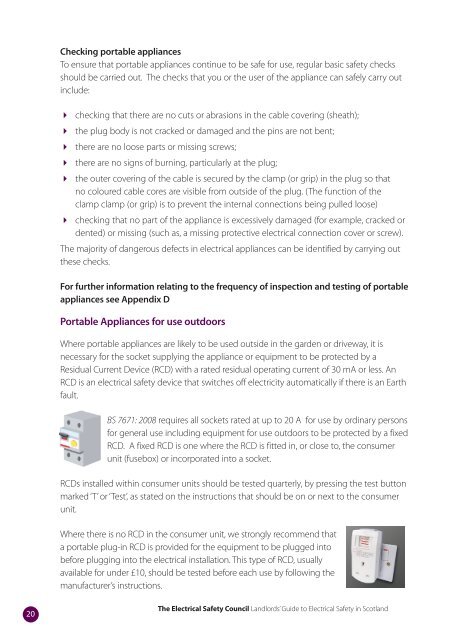Landlords' Guide to Electrical Safety in Scotland - Association of ...
Landlords' Guide to Electrical Safety in Scotland - Association of ...
Landlords' Guide to Electrical Safety in Scotland - Association of ...
Create successful ePaper yourself
Turn your PDF publications into a flip-book with our unique Google optimized e-Paper software.
Check<strong>in</strong>g portable appliances<br />
To ensure that portable appliances cont<strong>in</strong>ue <strong>to</strong> be safe for use, regular basic safety checks<br />
should be carried out. The checks that you or the user <strong>of</strong> the appliance can safely carry out<br />
<strong>in</strong>clude:<br />
check<strong>in</strong>g that there are no cuts or abrasions <strong>in</strong> the cable cover<strong>in</strong>g (sheath);<br />
the plug body is not cracked or damaged and the p<strong>in</strong>s are not bent;<br />
there are no loose parts or miss<strong>in</strong>g screws;<br />
there are no signs <strong>of</strong> burn<strong>in</strong>g, particularly at the plug;<br />
the outer cover<strong>in</strong>g <strong>of</strong> the cable is secured by the clamp (or grip) <strong>in</strong> the plug so that<br />
no coloured cable cores are visible from outside <strong>of</strong> the plug. (The function <strong>of</strong> the<br />
clamp clamp (or grip) is <strong>to</strong> prevent the <strong>in</strong>ternal connections be<strong>in</strong>g pulled loose)<br />
check<strong>in</strong>g that no part <strong>of</strong> the appliance is excessively damaged (for example, cracked or<br />
dented) or miss<strong>in</strong>g (such as, a miss<strong>in</strong>g protective electrical connection cover or screw).<br />
The majority <strong>of</strong> dangerous defects <strong>in</strong> electrical appliances can be identified by carry<strong>in</strong>g out<br />
these checks.<br />
For further <strong>in</strong>formation relat<strong>in</strong>g <strong>to</strong> the frequency <strong>of</strong> <strong>in</strong>spection and test<strong>in</strong>g <strong>of</strong> portable<br />
appliances see Appendix D<br />
Portable Appliances for use outdoors<br />
Where portable appliances are likely <strong>to</strong> be used outside <strong>in</strong> the garden or driveway, it is<br />
necessary for the socket supply<strong>in</strong>g the appliance or equipment <strong>to</strong> be protected by a<br />
Residual Current Device (RCD) with a rated residual operat<strong>in</strong>g current <strong>of</strong> 30 mA or less. An<br />
RCD is an electrical safety device that switches <strong>of</strong>f electricity au<strong>to</strong>matically if there is an Earth<br />
fault.<br />
BS 7671: 2008 requires all sockets rated at up <strong>to</strong> 20 A for use by ord<strong>in</strong>ary persons<br />
for general use <strong>in</strong>clud<strong>in</strong>g equipment for use outdoors <strong>to</strong> be protected by a fixed<br />
RCD. A fixed RCD is one where the RCD is fitted <strong>in</strong>, or close <strong>to</strong>, the consumer<br />
unit (fusebox) or <strong>in</strong>corporated <strong>in</strong><strong>to</strong> a socket.<br />
RCDs <strong>in</strong>stalled with<strong>in</strong> consumer units should be tested quarterly, by press<strong>in</strong>g the test but<strong>to</strong>n<br />
marked ‘T’ or ‘Test’, as stated on the <strong>in</strong>structions that should be on or next <strong>to</strong> the consumer<br />
unit.<br />
Where there is no RCD <strong>in</strong> the consumer unit, we strongly recommend that<br />
a portable plug-<strong>in</strong> RCD is provided for the equipment <strong>to</strong> be plugged <strong>in</strong><strong>to</strong><br />
before plugg<strong>in</strong>g <strong>in</strong><strong>to</strong> the electrical <strong>in</strong>stallation. This type <strong>of</strong> RCD, usually<br />
available for under £10, should be tested before each use by follow<strong>in</strong>g the<br />
manufacturer’s <strong>in</strong>structions.<br />
20<br />
The <strong>Electrical</strong> <strong>Safety</strong> Council Landlords’ <strong>Guide</strong> <strong>to</strong> <strong>Electrical</strong> <strong>Safety</strong> <strong>in</strong> <strong>Scotland</strong>

















